In 2017, Americans spent over $69 billion on their pets – a more than 4 percent increase over 2016.
Premium pet foods, luxury pet daycare and hotel facilities, and even treat and toy subscription boxes are just a few signs people are taking the way they care for their pets to a whole new level. Millennials especially –many of who say they approach being a pet owner like being a parent –have been known to splurge on their furry companions.
And being a cat mom or dog dad could even be good for your health. To learn more, we polled over 1,000 people about how caring for their pets affected their activity levels. We wanted to know whether being a pet parent made them more or less likely to work out and how pets might benefit other facets of their life. Do pets provide more than companionship and cute social media potential? Read on to find out.
Positive Impact of Pets
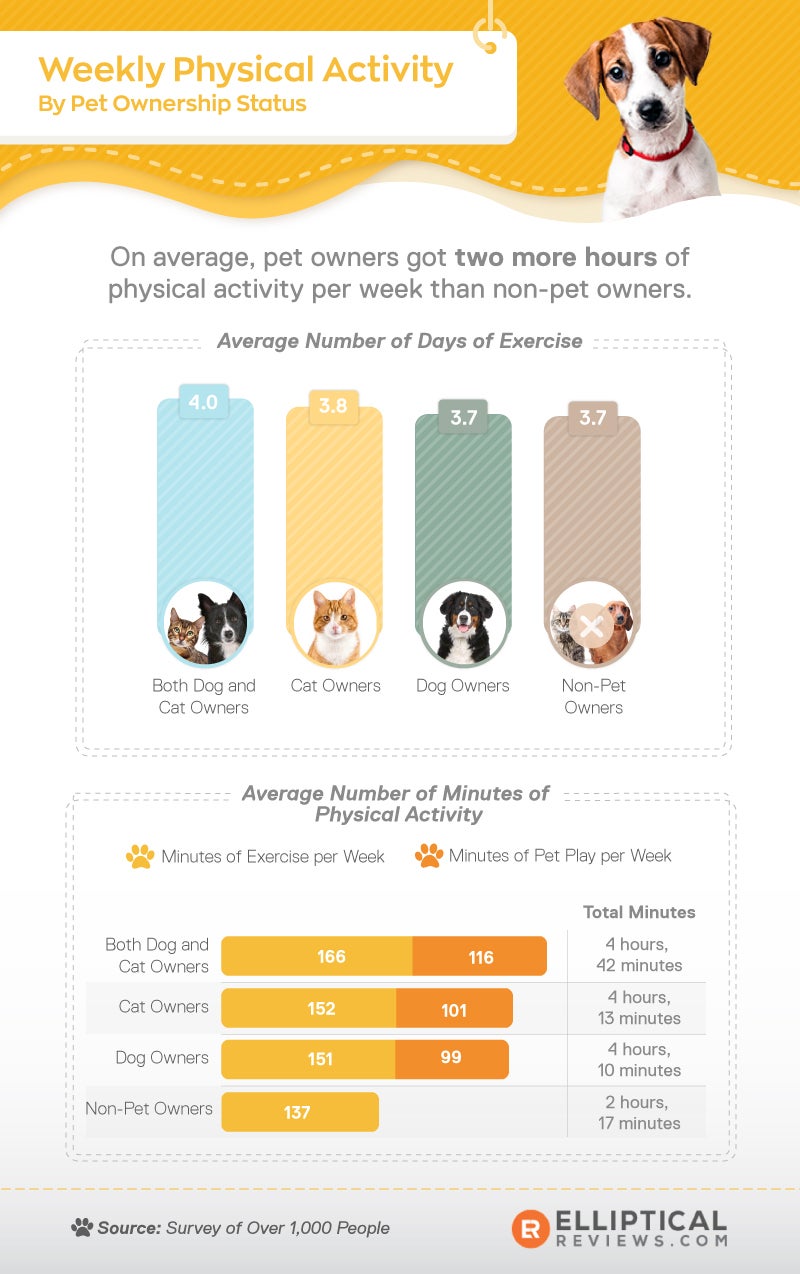
The Department of Health and Human Services recommends adults get at least 150 minutes of moderate exercise (or 75 minutes of vigorous aerobic activity) every week to maintain a healthy lifestyle. As it turns out, being a pet parent could help you get there.
If you’re a dog owner, you may be getting up to let your dogs out, taking them on routine walks, or possibly bringing them to local pet parks. Cat owners may not be taking their friendly felines outside as often as dog parents, but getting up to feed them or playing with them could help cat owners stay pretty active as well.
While non-pet owners and people with only dogs exercised the same number of days per week on average (3.7), cat owners (3.8) and people with both pets (4) averaged more workouts weekly.
Additionally, pet owners got at least an hour more each week of physical activity (including exercise and pet play) than non-pet owners. Compared to just 137 minutes per week of exercise for people without pets, people with both dogs and cats reported 166 minutes of exercise in addition to 116 minutes of pet play.
Two’s Company, Three’s a Fitness Class
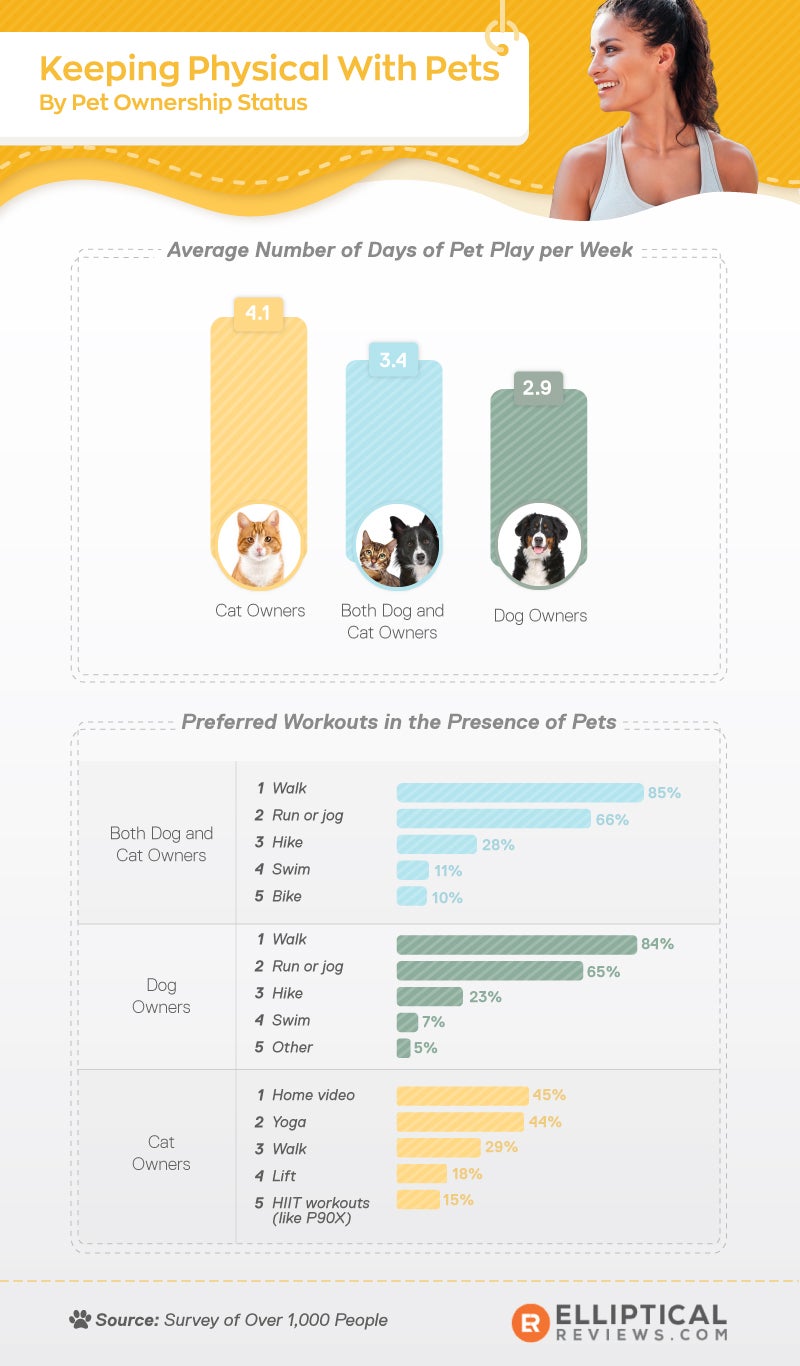
Goat yoga is a thing now, certain gyms will let patrons bring their pets to partake in the fitness fun, and some places even offer indoor pools catering to Fido and friends.
Considering all the exciting ways people can incorporate their pets into their workout routines, it’s no surprise respondents admitted there were certain exercises they thought were better done in the presence of their pets.
More than 4 in 5 people who owned both dogs and cats said they preferred to walk with their pets in tow, and nearly 2 in 3 said they didn’t like running or jogging without their pet.
For cat owners, 45 percent preferred doing home workouts with their feline companions nearby, and 44 percent preferred to do yoga in the company of their cats. Even 29 percent said they liked walking with their cats around. If that means walking outdoors, there are certainly options to keep your kitty in close proximity..
Dog Days
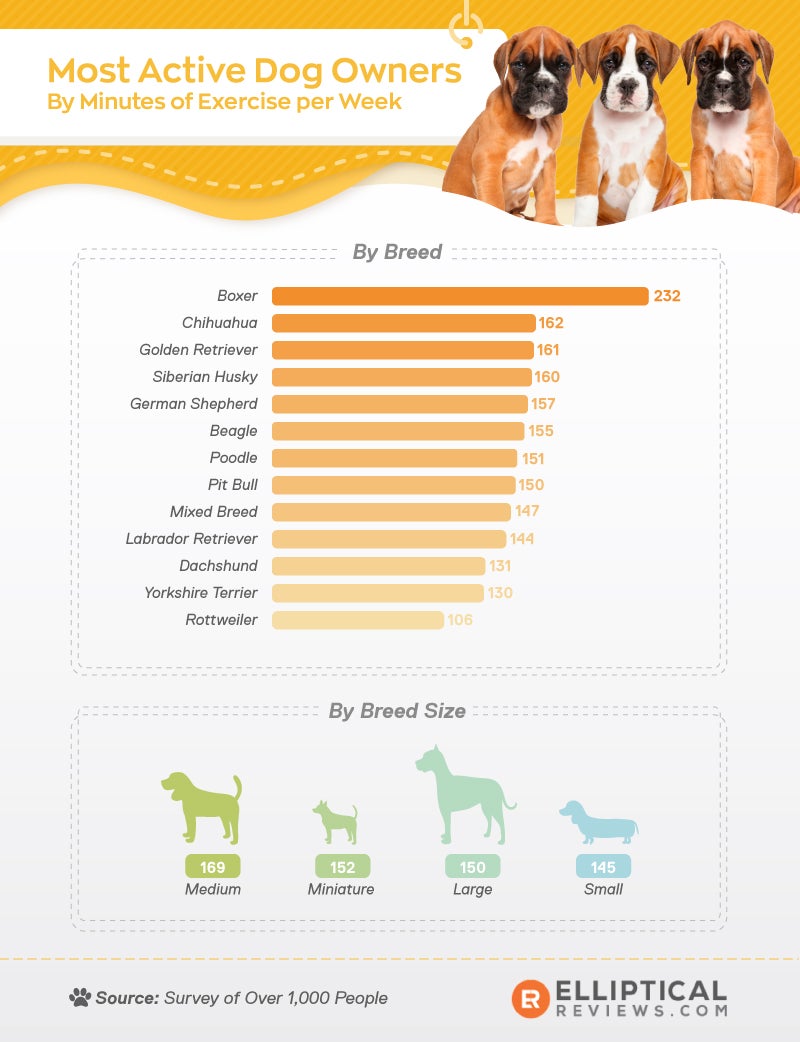
Most dog owners will tell you there’s more to picking the perfect pup than the way they look. Certain breeds are known to exhibit stronger personality traits than others, and knowing your dog’s personality in advance could help make sure you’re a compatible match for years to come.
In the same way that certain breeds are known for shedding or barking, some dogs are known for requiring extra physical activity to help quell their energy. People with boxers were more active than any other dog owner, clocking in 232 minutes of physical activity each week on average. Boxers are known for being fun-loving and energetic, so people who own them may start to pick up on the same tendencies as their powerful pooches.
It isn’t just big dogs encouraging their owners to stay fit, either. People with Chihuahuas were active for 162 minutes on average, followed by owners of golden retrievers, Siberian huskies, and German shepherds. In fact, it was medium-sized and miniature dog owners who said they were the most active.
Effective Encouragement
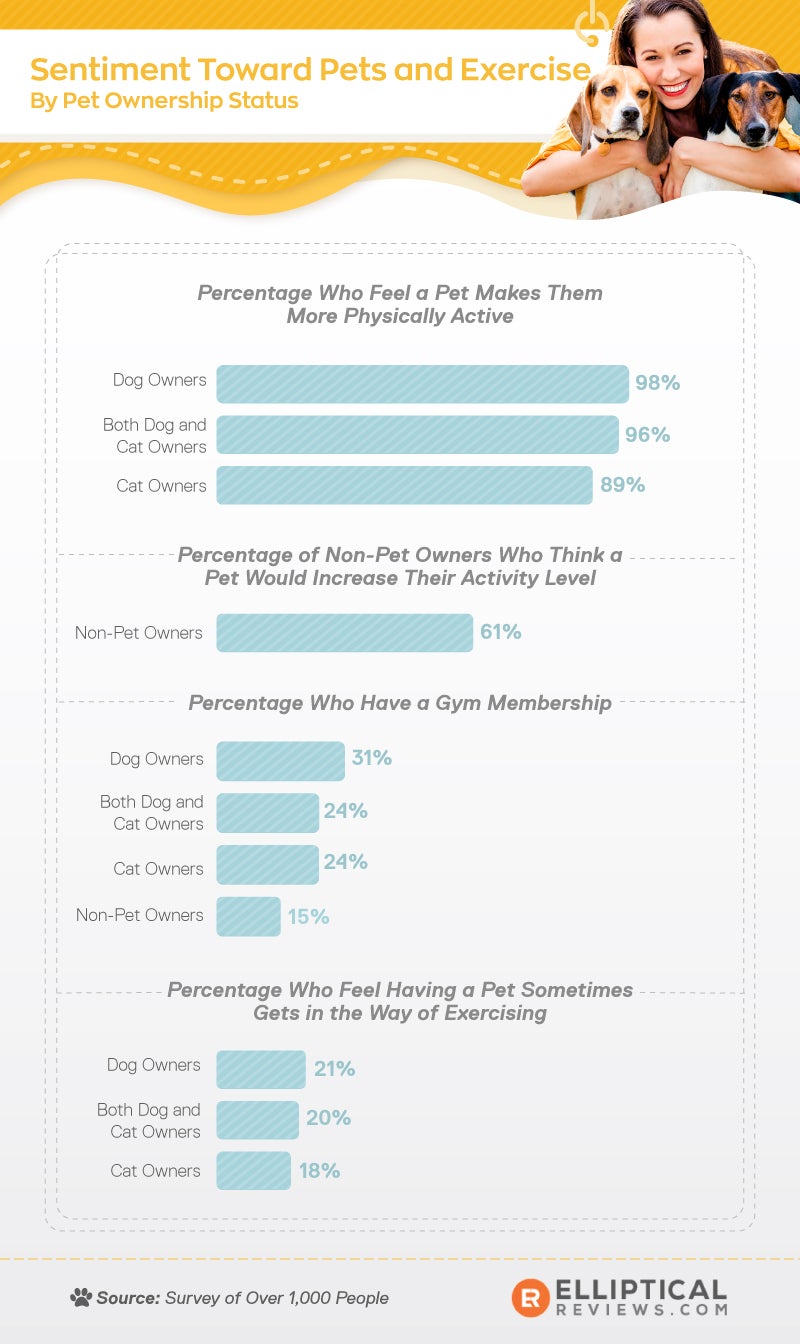
People say pets and their owners become more alike over time. In some cases, that can mean a physical likeness, but more often, it’s personalities that come together. Even if companionship is top of mind for people looking to bring a pet home, our pets may inspire and encourage us in ways we don’t expect.
According to our survey, 98 percent of dog owners said having a pet made them more physically active. Ninety-six percent of people with both dogs and cats said the same, and even though they may not be predominantly outside animals, 89 percent of people with cats said their feline friends made them more physically active. Sixty-one percent of people without a pet even admitted bringing an animal into their life would make them more active.
And even though 1 in 5 dog and cat owners said having a pet sometimes got in the way of exercising, they were more likely than people without pets to have a gym membership.
Critter Comforts
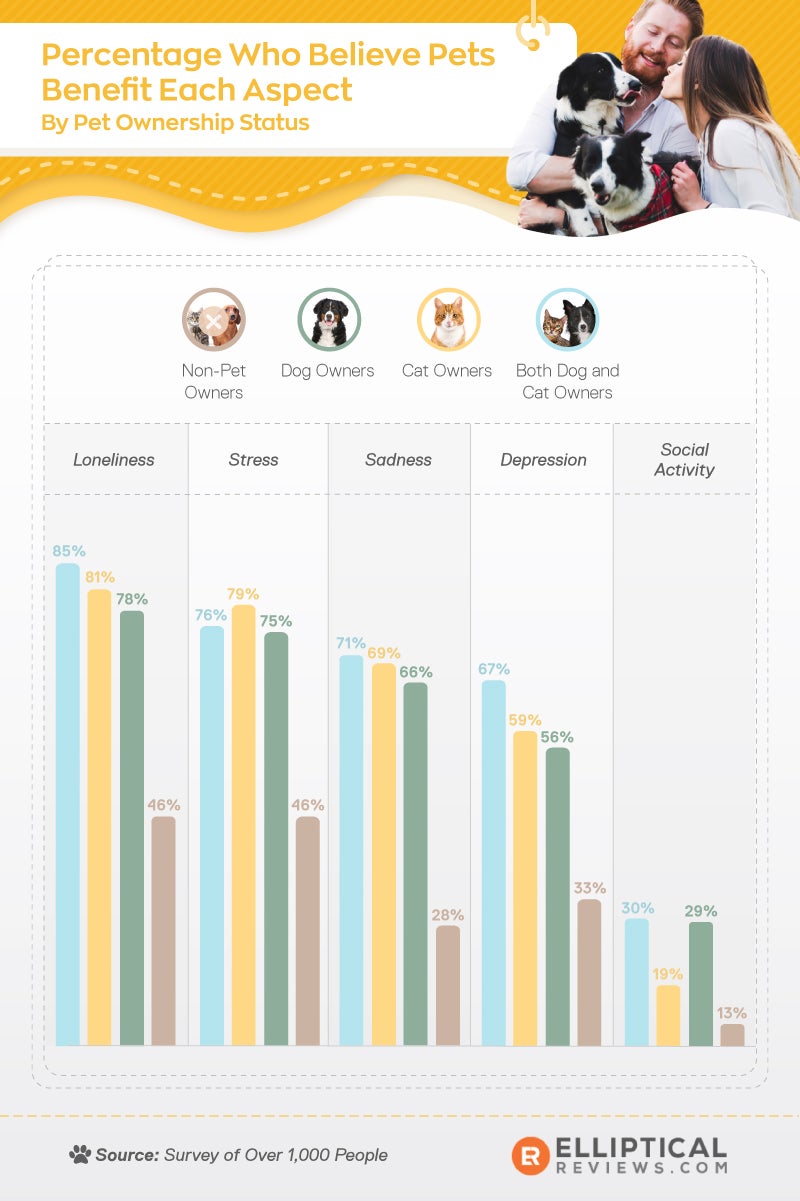
Pets can be a costly investment. Even if you aren’t planning to sign up for a monthly day care membership or premium food, there’s a certain expense associated with caring and providing for a living creature. As we found, pets don’t just pay back that cost with love and loyalty; they may also help inspire their owners to be more active.
The health benefits of owning a pet aren’t entirely physical, though. People with dogs, cats, or both were more convinced their pets helped them feel less lonely, stressed, sad, and more socially active than people without pets. Cat owners had the strongest opinion of their pet’s ability to help them decompress after a long day,and more than 2 in 3 people with both dogs and cats said their animals helped them manage feelings of depression.
Perks of Pet Ownership
You might think you’re too busy to own a pet. In addition to the cost, pets require both our time and energy to be properly cared for. Adding a pet to your life might have a more energizing effect than you anticipate, though. People with cats and dogs were more likely to have gym memberships and said their pets helped increase the amount of time they spent doing things like walking, jogging, and working out.
Those aren’t the only perks you can expect with a pet either. Whether it’s their physical presence or their ability to help us be more physically active (which can help lessen the symptoms of depression), people with pets were also more inclined to suggest their furry friends made them happier and more social too.
About EllipticalReviews
At EllipticalReviews.com, we compare brands and prices so you can find the right equipment for your fitness goals. Whatever your immediate exercise needs are, EllipticalReviews.com is your elliptical resource.
Methodology
We collected results from a survey of 1,058 people. Twenty-eight percent of respondents owned both cats and dogs, 28 percent owned only cats, 40 percent owned only dogs, and 4 percent owned no pets. Participants ranged in age from 18 to 81, with a mean of 36 and a standard deviation of 11. No statistical testing applied and the results of this study are exploratory.
Fair Use Statement
Think your readers will enjoy this positive pet data? Feel free to share this article (and any associated treats) on your site for noncommercial use only. Play nice by ensuring a link back to this page so that our contributors earn credit for their work too.


